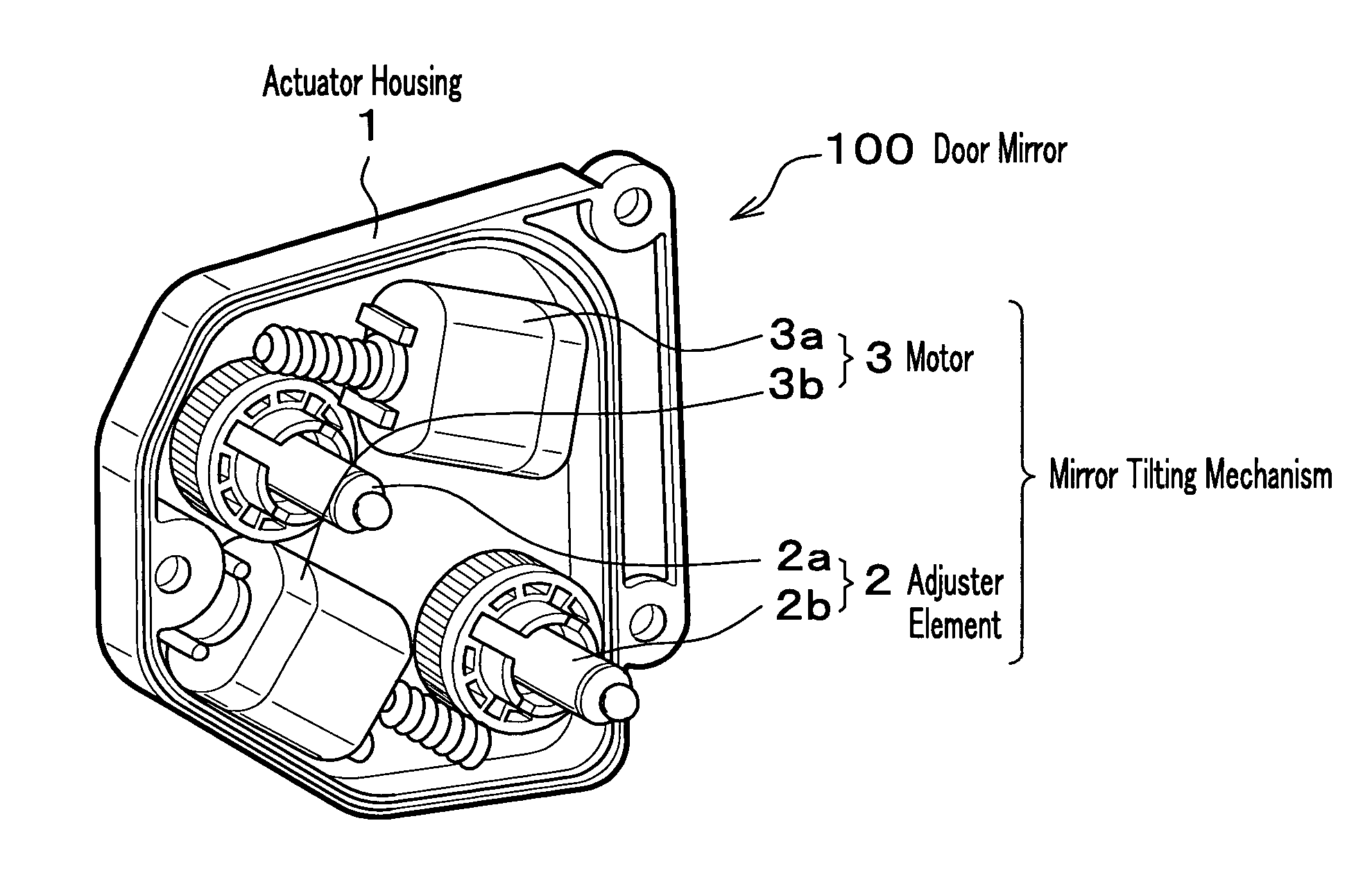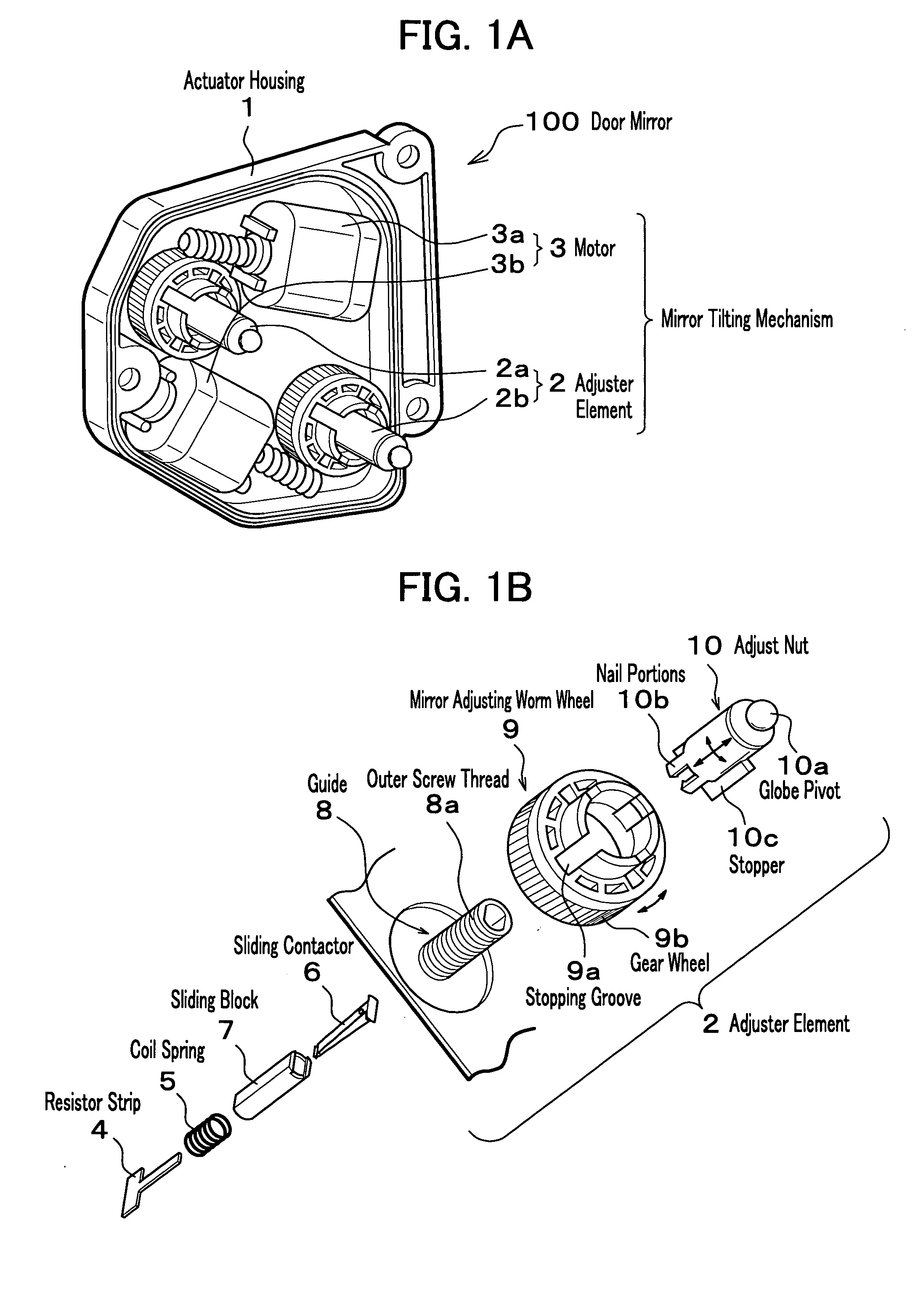Mirror angle transducer and mirror tilting mechanism
- Summary
- Abstract
- Description
- Claims
- Application Information
AI Technical Summary
Benefits of technology
Problems solved by technology
Method used
Image
Examples
first embodiment
(First Embodiment)
[0036] The first embodiment of the present invention is shown in FIG. 1A and FIG. 1B.
[0037]FIG. 1A is a schematic that shows an actuator used for the mirror angle adjustment for which the mirror angle transducer is used. The door mirror 100 is composed of the actuator to which the mirror angle transducer is used as shown in FIG. 1A. The mirror tilting mechanism is assembled in the actuator housing. The mirror tilting mechanism is composed of two sets of an adjuster element 2 (actually 2a or 2b), a motor 3 (actually 3a or 3b) with a worm set in the motor shaft. The detail assembly of the adjuster element 2a or 2b is shown in FIG. 1B.
[0038] There are two adjuster elements 2a and 2b used for the mirror tilting mechanism 2 constructed in the actuator housing 1. The adjuster elements 2a and 2b are driven by two motors 3a and 3b with worms, respectively and can tilt the mirror in the vertical plane and the horizontal plane.
[0039] The adjuster element 2b, for example, ...
second embodiment
(Second Embodiment)
[0053]FIG. 5B shows the second embodiment of the present invention. The difference from the first embodiment of which details are shown in FIG. 5A is that a pair of clip holes 16a, a pair of through holes 17a and a pair of clips 18 are used to make mechanical tightness between the sliding contactor 16 and the sliding block 17.
[0054] One clip 18 is inserted into one through hole 17a made in the sliding block 17 and one clip hole 16a made in the sliding contactor 16. The other clip 18 is inserted into the other through hole 17a made in the sliding block 17 and the other clip hole 16a made in the sliding contactor 16. The tips of the clips 18 become wider than the diameter of the clip holes 16a and hardly drop off from the clip holes 16a. The clips 18 make the sliding contactor 16 latched to be fixed to the sliding block 17. This latch mechanism keeps the complete stability against the rotational friction to the adjust nut 10 which mechanically contacts to the slidi...
third embodiment
(Third Embodiment)
[0056]FIG. 5C shows the third embodiment of the present invention. The difference from the first embodiment is that a pair of rivet holes 26a, a pair of through holes 27a and a pair of rivets 28 are used to make mechanical tightness between the sliding contactor 26 and the sliding block 27.
[0057] One rivet 28 is inserted into one through hole 27a made in the sliding block 27 and one rivet hole 26a made in the sliding contactor 26. The other rivet 28 is inserted into the other through hole 27a made in the sliding block 27 and the other rivet hole 26a made in the sliding contactor 26. By using a special tool, the tips of the rivets 28 are pressed to be wider than the diameter of the rivet holes 26a and hardly drop off from the clip holes 26a. The rivets 28 stake the sliding contactor 16 to be fixed to the sliding block 27. This stake mechanism keeps the complete stability against the rotational friction to the adjust nut 10 which mechanically contact to the sliding ...
PUM
 Login to View More
Login to View More Abstract
Description
Claims
Application Information
 Login to View More
Login to View More - R&D
- Intellectual Property
- Life Sciences
- Materials
- Tech Scout
- Unparalleled Data Quality
- Higher Quality Content
- 60% Fewer Hallucinations
Browse by: Latest US Patents, China's latest patents, Technical Efficacy Thesaurus, Application Domain, Technology Topic, Popular Technical Reports.
© 2025 PatSnap. All rights reserved.Legal|Privacy policy|Modern Slavery Act Transparency Statement|Sitemap|About US| Contact US: help@patsnap.com



